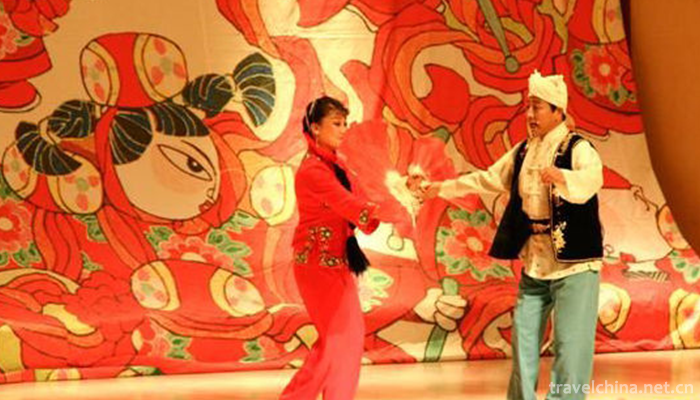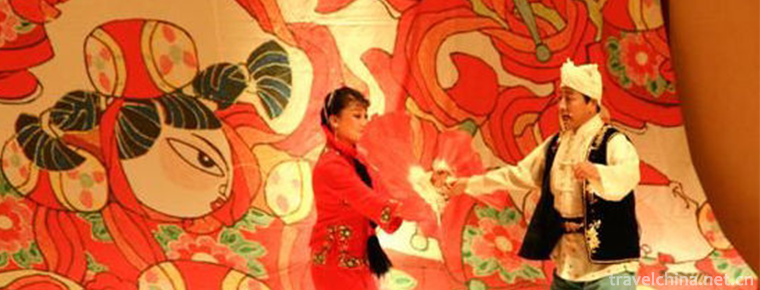Hequ folk songs
Hequ folk songs
Hequ folk song is a kind of traditional folk music. Shanxi's human geographical environment has formed the "Xikou" mode of life and production in which local people return to Daqingshan and Hetao in Inner Mongolia every spring and winter for short-term and long-term work. From this painful life of divorcing wife and son year after year, there naturally arises the folk song "Going to the West Pass", which sings about human suffering, thoughts, and expectations. The local people call it "Shanqu". The melody of Shanqu is composed of juxtaposition, echo and contrast, which contains rich aesthetic meanings. It is also of typical significance in reflecting the development history of Chinese folk songs and the living conditions of Chinese civil society.
On May 20, 2006, "Hequ Folk Song" declared by Hequ County of Shanxi Province was listed in the first batch of national intangible cultural heritage list with the approval of the State Council.
historical origin
Hequ folk songs are popular in Hequ County and northwest Shanxi, radiating the border areas of Shanxi, Shanxi and Mongolia provinces (regions). Hequ is located in the northwest of Shanxi Province, with the eastern boundary of Pianguan and Wuzhai, the southern boundary of Dalan and Baode, and the western and northern boundary of the Yellow River adjacent to Shaanxi and Inner Mongolia respectively. It is a special area of "one chicken and three provinces". Located in the bend of the Yellow River, the river meander was historically blocked by traffic, barren land, uncertain droughts and floods, and people suffered serious disasters. This special cultural and geographical environment has formed the way of life and production of local people who go to Daqingshan and Hetao in Inner Mongolia every spring and winter to do short-term and long-term work. From this painful life of divorcing wife and son year after year, there naturally arises the folk song of "going to the West Pass" which sings about human suffering, thoughts and expectations. The local people call it "Shanqu".
Shanqu belongs to the genre of folk songs. It has not yet been determined when it was formed, but the "Er Er Tai" formed on the basis of Shanqu has a history of about 200 years according to textual research. There is a record in the local chronicles of the Ming Dynasty river song "household chord song new governing score, children and old women singing as much as possible", which shows the long tradition of its singing. Hequ County has always been based on farming. Nine years of drought, famine and traffic congestion have gradually formed a special geographical environment for the growth and inheritance of traditional folk culture. Thus nurtured and gave birth to a unique style of Hequ folk songs, which is a precious artistic variety. It has gone through thousands of years of history of singing and gestation period, singing for a long time.
artistic characteristics
Hequ folk song is rich in content, covering all aspects of social life, it "see what to sing, think what to sing", to show the local folk customs. It uses such techniques as comparison, repetition, parallelism, overlap, symmetry, pun and exaggeration to express the joys and sorrows of life. The melody is simple, graceful, the interval jump is big, the tone is high and broad, the rhythm is relatively free, the colloquial decorative sound is more, has the distinct folk song flavor.
The lyrics of Shanqu are profound and rich in melody. In the winter of 1953, the National Music Research Institute of the Central Conservatory of Music (now the Music Research Institute of the Chinese Academy of Arts) first went to collect folk songs. In just three months, it recorded more than 1,500 lyrics and more than 150 melodies, including "Three days'journey, two days' arrival", "People are away", "Cutting naked oats", "Raising Brother to the West Pass", "True Soul Following You" Around","Brother in the East Sister in the West, Tianhe separated from the two ends"and so on are excellent handed down from generation to generation.
In terms of the structure of Ci and Song, they adopt the form of upper and lower sentences, which arouse the interest of the upper sentences and the expression of the lower sentences, often revealing a deep emotional state or depicting a lifelike picture of life, such as "mountains and waters are in the rock, people are not in you", "hear your brother sing, warm up on the cold windowsill" and so on are typical examples. The melody of Shanqu is composed of juxtaposition, echo and contrast, which contains rich aesthetic meanings. It is also of typical significance in reflecting the development history of folk songs and the living conditions of civil society.


-
1.Cattle back Mountain Niubeishan Mountain
Niubei Mountain is located in the border of Xingjing County and Luding County in Ya'an City, Sichuan Province. It is the watershed between Qingyi...
Time 2018-10-13 -
2.Turtle Head Islet
Yuantouzhu is a peninsula lying on the northwest coast of Taihu Lake in Wuxi. It is named for its huge stone bursting into the lake in the shape of a tortoise with its head held high. Yuantouzhu
Time 2018-12-06 -
3.Kunming World Horticultural Expo Garden
Kunming World Horticulture Expo Garden (hereinafter referred to as the World Horticulture Expo Garden) is the site of the 1999 Kunming World Horticulture Expo.
Time 2018-12-12 -
4.The tru Valley
Turugou is located in Liancheng Forest, Yongdeng County, 160 kilometers northwest of Lanzhou City. It belongs to the eastern foot of Qilian Mountains.
Time 2019-02-22 -
5.Hongdongs custom of visiting relatives
The custom of walking relatives in Hongdong is a kind of Han traditional folk culture which spreads in Ganting, Wucun, Xincun, Longma and Wanan townships
Time 2019-05-03 -
6.Eighteen General Martial Arts
A traditional term of Chinese Wushu, also known as "Eighteen Weapons" and "Eighteen Weapons", is commonly used in ancient Chinese operas and novels, referring to the use of various
Time 2019-06-15 -
7.Ming opera style
On May 20, 2006, Yiyang Opera was approved by the State Council of the People's Republic of China to be listed in the first batch of national intangible cultural heritage, numbered IV-5.
Time 2019-07-13 -
8.Sun Tzu
Sun Wu (about 545 BC - about 470 BC), long Qing, late spring and autumn. Qi State Le An (today) Shandong ProvincePeople in the North 。 China's famous military strategist and statesman in the spring an
Time 2019-09-04 -
9.Chongzhou Confucian Temple
One of the four best preserved Confucian temples in Sichuan Province. National key cultural relics protection units. Confucius Cultural Center in Western China. It is located in the south of Chongzhou painting pool.
Time 2020-11-05 -
10.Dispute on the meaning of Cheongsam
Under the influence of the Qing Dynasty's Qiren's robes, women's gowns have been referred to as cheongsam since the Republic of China. Due to the influence of the environment at that time, most people know that the women of the Manchu and Qing Dynasty had their own cheongsam,
Time 2020-12-11 -
11.Ecological environment of Luzhou
On July 5, 2019, the Ministry of ecology and environment of the people's Republic of China announced the special investigation of black and odorous water bodies in the first stage of overall planning and strengthening supervision in 2019. Luzhou was listed in the "list of cities whose
Time 2020-12-14 -
12.Suining economic development
In 2019, Suining's GDP will reach 134.573 billion yuan, an increase of 8.1% over the previous year (the same below) at comparable prices. Among them, the added value of the primary industry was 18.521 billion yuan, an increase of 2.7%; the added value of the
Time 2020-12-16